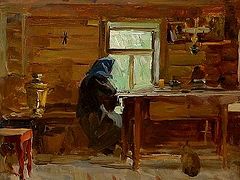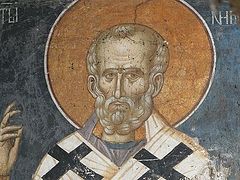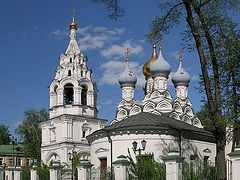Despite persecution
Seventeen versts1 from Moscow, on the Gorodenka River, was the village Biriulevo of the Zyuzinskaya Township. In 1900, a railroad passed through these places. In 1903, a railroad school was opened at Biriulevo Station, and in 1911, a church was added to it. A year later, the church was consecrated in the name of the Right-Believing Great Prince Alexander Nevsky.
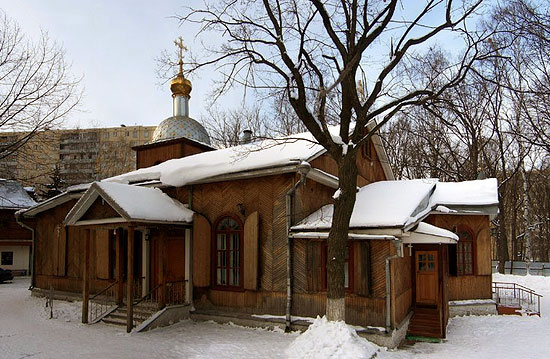 Church of St. Nicholas the Wonderworker in Biriulevo. Photo: Sobory.ru
Church of St. Nicholas the Wonderworker in Biriulevo. Photo: Sobory.ru
This happy time was short-lived. World War I erupted and then the revolutionary coup occurred. And in 1918, the persecutions against religion began. The faithful tried to prevent the closing of the church in Biriulevo. They registered the community and signed a contract with the Moscow District Council to transfer the church to it in perpetuity and free of charge. But the authorities tried to break this resistance. And it already seemed they had won: In March 1924, the church was closed, and in May, it was liquidated. Its property went to the nearby Holy Protection Church.
But on June 21, 1924, by the prayers of St. Tikhon, the Patriarch of Moscow and All Russia, and at the request of the faithful, permission was obtained from the Presidium of the Moscow Council to build a new church in Biriulevo on the territory of the cemetery that appeared in 1917. A wooden church was quickly erected. On December 14, 1924, it was consecrated in the name of St. Nicholas the Wonderworker. Six months later, an agreement was signed with the Moscow District Council of Workers and Red Army Deputies to transfer the church with its bell tower, gatehouse, and cemetery to the community for free usage.
The entire subsequent history of this church evokes great wonder: How was it possible to save it during the years of terrible persecution and repression? Why was it reborn even in the most seemingly hopeless situations, when many considered it lost?
To find answers to these questions, we must first find out who prayed and prays for the preservation of the church—whose prayers reach the Lord.
By the will of the Tsar-Martyr
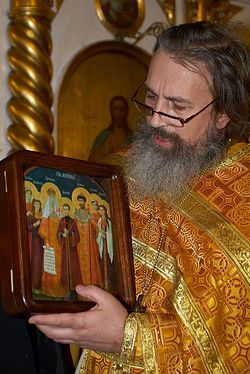 Fr. Konstantin Kobelev with an icon of the Royal Martyrs. Photo: Denis Polunin The people know their intercessors and mediators before God. And, probably, first among them for the parishioners and clergy of the church was the holy Tsar-Martyr Nicholas II.
Fr. Konstantin Kobelev with an icon of the Royal Martyrs. Photo: Denis Polunin The people know their intercessors and mediators before God. And, probably, first among them for the parishioners and clergy of the church was the holy Tsar-Martyr Nicholas II.
Why, in recreating the lost church, didn’t they keep its old name—of the holy Right-Believing Prince Alexander Nevsky? After all, all the property of this church was preserved intact. Nevertheless, on behalf of the faithful, a request was made to His Holiness Patriarch Tikhon to assign the name of St. Nicholas to the future church.
No documentary evidence for this story has been preserved, but now many clergymen and parishioners of the church believe that their predecessors in the 1920s desired to hear the name of the Emperor Nicholas Alexandrovich in the name of their church. Not wanting to participate in the sin of renouncing the anointed of God and regicide, but to promote his memory in subsequent generations, the people believed that they did not lose but rather found intercessors and helpers before the Lord—the pious Tsar Nicholas and his family, who suffered martyrdom for Christ. And the people’s faith was not in vain.
The new church in Biriulevo was one of very few built in the 1920s. When churches were being destroyed everywhere, sacred treasures were being desecrated, and clergy and laity were being slaughtered, prayer was being lifted up in a small village near Moscow and the Divine Liturgy was being celebrated.
In the last years of the communist yoke, one devout old woman was praying to St. Nicholas in the church during Lent for the salvation of Russia. And then, a mist as if spread out before her eyes, in the haze of which two people appeared to her. First came St. Nicholas the Wonderworker, leading Tsar Nicholas Alexandrovich by the hand. Turning to the woman praying, St. Nicholas the Wonderworker said: “Why are you entreating me? Russia now has an intercessor, pray to him!” and pointing to the Tsar, he added: “This is the new St. Nicholas, the right-believing Tsar-Martyr, a holy intercessor for Russia and for the Russian people.”
By the prayers of Mother Seraphima
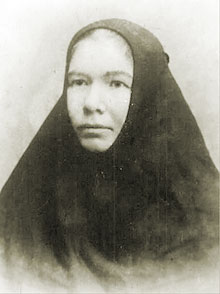 Schemanun Seraphima (Ushakova). Photo: st-nikolas.orthodoxy.ru The preservation of the church was probably also possible because Blessed Schemanun Seraphima (Ushakova) of Biriulevo was praying for it. There are many confirmations of this in the story of her life.
Schemanun Seraphima (Ushakova). Photo: st-nikolas.orthodoxy.ru The preservation of the church was probably also possible because Blessed Schemanun Seraphima (Ushakova) of Biriulevo was praying for it. There are many confirmations of this in the story of her life.
Sophia Ilinichna Ushakova was born in 1875 to a family of noble parents and lived with them in the city of Kashin. She was pretty, tall, slender, and strong. She was promised in marriage to a good man, also of a noble family.
When the question about the wedding arose, the maiden asked her parents to wait one night—to pray that the Lord reveal whether there would be a marriage or that she would go to a monastery. Her parents agreed, and God revealed to her that He would be pleased for her to become a nun. The rich, pampered maiden decided to become a novice in the Prince Vladimir Monastery in Filimonki.
At one point she became very ill. She had a high temperature, and they were taking her unconscious on a sleigh to the doctor when a blizzard began to rage. On the way, the sleigh was shaking violently. They didn’t immediately notice that the patient had fallen out, and suddenly realizing it, they couldn’t find her for a long time. They found her completely frozen, covered in snow, and severely frostbitten. From that time, her arms and legs remained twisted, and her body was covered with sores.
In 1928, the monastery was closed. The sisters scattered wherever they could. Only the bedridden Schemanun Seraphima remained. She was carried out of the monastery on a bed into the icy cold (it was late November). She caught a bad cold and practically didn’t move from then on.
In Filimonki, there was a fourteen-year-old girl named Maria who worked as a nanny. She ran to her aunt, Nun Apollinaria, who lived with other people in a house nearby, and began weeping, asking her to take the sick Matushka Seraphima in. But where to put her?! Nevertheless, they walled off a warm place and took her in, although the owners and neighbors strongly objected. They were especially displeased with the stream of visitors to Matushka Seraphima.
From then on, for twenty-two years, until Matushka’s very death, Maria was her cell attendant.
People from Moscow and many other places came to the clairvoyant Schemanun Seraphima for spiritual guidance and prayerful help. To some she would give a word, to others she gave water from the cross, to others oil. And those who came were delivered from spiritual and bodily ailments.
Mother was always welcoming, and she held a cross and a prayer rope in her hands. And almost no one realized the physical sufferings of Blessed Seraphima, who lay on airy pillows for ten years because of her oozing sores, half-paralyzed, with twisted arms and legs.
Matushka’s prophecies helped many avoid troubles and even death. Her prayer led people from their spiritual wanderings to the path of truth. The Lord gave Matushka mystical revelations by which she knew the names of people who had just come to her—their intentions, their secret desires, and their true needs.
People were drawn to Matushka. Sometimes as many as forty people were stuffed into her small room. Before her repose, she revealed to the rector of the Biriulevo church, Fr. Nikolai Perekhvalsky, that after her death, prayer at her grave would help the sick.
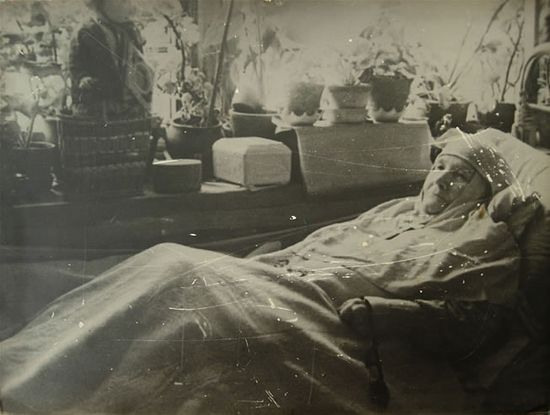 Schemanun Seraphima (Ushakova). Photo: st-nikolas.orthodoxy.ru
Schemanun Seraphima (Ushakova). Photo: st-nikolas.orthodoxy.ru
Matushka died on Forgiveness Sunday, February 17, 1950, and her arms and legs straightened out after death.
When they carried her coffin out of the house, everyone saw a huge, fiery cross in the sky. Her funeral was served according to the monastic rite, and she was carried around the church and buried behind the altar. On her grave was placed the cell cross that she kept in her room for many years as a relic from Prince Vladimir Monastery in Filimonki.
In 1960, the village became part of the Proletarsky District of Moscow (now the Southern District). In 1977, according to the plan for developing the Biriulevo-West subdivision, the cemetery where the soviet authorities once allowed the construction of the St. Nicholas Church was barbarically destroyed. The rector of the church, Archpriest Vasily Moiseev, obtained permission to rebury the remains of several people on the territory of the church, including Schemanun Seraphima.
In July 1979, after twenty years in the ground, Matushka’s body was lifted out of the grave and placed in a spacious coffin on a new burial shroud. Her clothes were completely intact, and her relics incorrupt. Fr. Alexei Baikov, who reburied Matushka, put the cross in her hands again (it fell out when they took out the old coffin). And a girl named Martha couldn’t believe her eyes. “Matushka seems to be sleeping,” she said, and reached out her hand and touched her. Then she fell seriously ill for three weeks for her disbelief.
Every day since the repose of Matushka Seraphima, fresh flowers and candles are placed on her grave. There is always a lampada burning in the tin case at the base of the cross. Panikhidas are often served there. People gather and pray. They ask for help, and then they return to thank Matushka. They come for advice and ask for a blessing. They gather dirt, pluck blades of grass, apply to them to the afflicted spots, and they are healed.
The many miracles performed by Matushka’s prayers during her life and after her death testify that Blessed Seraphima of Biriulevo never ceased and will never cease her intercession before the Lord and the Mother of God for all who ask her help.
Risen from the ashes
According to one of the clerics serving in the church now, Fr. Konstantin Kobelev, it is Schemanun Seraphima who is the builder of the new church of St. Nicholas the Wonderworker in Biriulevo, built in place of the old one that burned in 1957.
Shortly before her death, Matushka Seraphima foretold to Fr. Vasily Moiseev, still a young priest then, that he would build a church: “Fr. Vasily mentioned it once, and people told me about it,” recalls the vicar of the Moscow Diocese Archbishop Arseny of Istra. “Fr. Vasily and Fr. Nikolai Perekhvalsky had some difficulties in their relationship. When their relationship became too acute, Fr. Vasily felt it necessary to go to Matushka Seraphima and ask her blessing for how best to proceed. “Should I leave?” to which Matushka replied: “Be patient. The rector will repose; the church will burn before forty days pass and you’ll have to build a new one.”
And indeed, not even three weeks passed after the death of Fr. Nikolai when, during a memorial service in the cemetery, someone started shouting: “The church is burning!” They went running, but it was already engulfed in flames. Nearly everything in the church burned, and even the bells melted.
The crosses and trees around the church also burned. Only the wooden cross on the grave of Matushka Seraphima remained among the ashes—only the lower part was slightly charred. Of the former church, built in 1924, only the foundation remained.
The fact that during the years of the godless evil the parishioners of the burned church did not allow the parish community to be destroyed and managed to withstand the sophisticated methods of the authorities is undoubtedly a miracle of God.
The Lord then enlightened the people to adapt the church’s gatehouse for a place for prayer. Services resumed there just ten days later.
The church council and community of believers repeatedly petitioned to allow the construction of a new church and they were always refused. Then it was decided undertake a thorough improvement of the gatehouse. Timber and other building materials were brought in under the cover of night. They gradually made small additions and then dismantled the inner walls of the gatehouse, thus increasing the space of the church. They all worked together, tirelessly.
But the authorities had to liquidate the parish. To do this, they had to record the absence of the structure (the prayer house) as such. The faithful found out when the commission would arrive to officially establish that the church, and therefore the parish, did not exist. The disturbing news instantly spread throughout the entire district.
Both the men and the women worked all night installing the rafters in the new church. In the morning, the commission had to state that “the structure exists.” Thus, by a miracle of the Lord and the zeal of Orthodox Christians, the Orthodox parish was saved. By the prayers of Matushka Seraphima, in 1957 the parishioners and priests built a new church with their own means and their own hands in the shortest possible time. There was a memorial plaque hung on the wall of the trapeza telling about this, but it had to be removed by order of the district executive committee.
“Why is everything so good?”
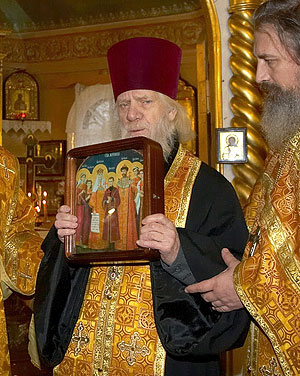 Mitred Archpriest Alexei Baikov. Photo: Denis Polunin One of the witnesses to the entire history of the church is fortunately still alive: the oldest, most respected, and most beloved of the priests—Mitred Archpriest Alexei Baikov [Fr. Alexei reposed in the Lord on May 10, 2017, several years after this article was originally published—Trans]. His more than half a century of ministry in the St. Nicholas Church is a vivid example of how dignified, happy, and long a man can live, remaining faithful to his church and its Heavenly protectors.
Mitred Archpriest Alexei Baikov. Photo: Denis Polunin One of the witnesses to the entire history of the church is fortunately still alive: the oldest, most respected, and most beloved of the priests—Mitred Archpriest Alexei Baikov [Fr. Alexei reposed in the Lord on May 10, 2017, several years after this article was originally published—Trans]. His more than half a century of ministry in the St. Nicholas Church is a vivid example of how dignified, happy, and long a man can live, remaining faithful to his church and its Heavenly protectors.
—I have gramotas from three patriarchs (and many other awards),” Batiushka told me. “The last gramota was from His Holiness Patriarch Alexei II. Vladyka Arseny gave it to me recently, on the feast of the “Unexpected Joy” Icon of the Mother of God. He said kind words about me, and the next day I cried so much!
—Why?
—From joy. O Lord, why is everything so good in my life?! Then I calmed down and told myself: “This is as it should be.” It couldn’t have been any other way. I’ve been serving here for fifty-three years. I’ve said it before and I’ll say it now: Our church is blessed and prayerful.
—You mean that everything should be all right in such a prayer-filled church? It’s prayerfulness is your merit, Batiushka. Please tell us about your ministry.
—I was born in Serpukhov in 1929. My father was a deacon there. The ruling hierarch was Vladyka Manuel (Lemeshevsky) then, and he later became Metropolitan of Kuibyshev and Syzran. My father told him: “Vladyka, we had twins.” And he replied: “I’ll baptize the younger one myself.” And he was named Alexei, in honor of the Metropolitan of Moscow, whose day we mark on June 2.
—He didn’t baptize the older one?
—No, just me, the sinner Alexei. And I became a priest, but my brother Nikolai did not. When I was a little boy, I saw Metropolitan Manuel. My mother told me: “That’s your Godfather—Vladyka.” I immediately took his blessing. He looked at me very carefully (that’s probably why my mother was sweating): Was I wearing a cross or not? It was scary to wear a cross then, and some mothers sewed it into their child’s underwear. But I was wearing a cross on a chain on my neck. It was always on me, even in the terrible year of 1937.2 The other guys would shout at me: “Look, here comes the priest!”3 I paid them no mind. When they continued to harass me, I would answer: “I will be a batiushka.” They would go their way, and I mine.
—Your parents weren’t afraid for you?
—No, they were very religious.
I served with His Holiness Patriarch Alexei (Simansky) at Theophany Cathedral for four years (my father was the protodeacon there). But we lived far from there, at Elk Station. I would get up early. The others would still be sleeping and I was already gone.
There were two elderly protodeacons at the church there. I would say to them: “Sleep, rest—I’ll serve.” They were so glad! I was glad too: I served both morning and evening. What can I say? I was young.
I remember, one day His Holiness Patriarch Alexei (Simansky) came to serve at the early Liturgy. The Liturgy ended, and everyone came up to him, beginning with the rector. I came up last. He looked at me with those eyes… I wanted to serve as a deacon. I already had a place, although I didn’t say a word about it to the Patriarch; but he said to me: “You will be ordained as a priest on the feast of St. Nicholas.”
I was so upset! I went home. My father said: “What’s the matter?” I told him everything. And he told me (memory eternal, Papa!): “It’s God’s will. That’s how it should be.” December 19, 1955, His Holiness ordained me as a priest. Ten days later, I was appointed here, to Biriulevo…
—You wound up at the Church of St. Nicholas the Wonderworker two months before it burned?
—Yes, our church burned on March 1, 1956. I lived close then and saw the fire immediately. I don’t remember running there. I looked, and the whole church was engulfed in flames, black smoke billowing. I rushed to the church to take out the sacred items, but some force pushed me away. And imagine—at that moment the burning roof collapsed! If I had entered the church a second earlier, I would have remained there. The Lord saved me.
Then we decided to hold services in the guesthouse. We made a small altar and altar table. There was a narrow door made of plywood, and we would come out of it sideways with the Holy Gifts. However, the little building was gradually expanded and additions were made to it. As I remember now, they laid logs and immediately painted them green so the construction would be unnoticeable.
Time passed. The building increased significantly. It became like a church. But in the soviet times, they called it a “house of prayer.” And on Sunday, December 22, 1957, on the feast of the Icon of the “Unexpected Joy,” the church was consecrated.
As a young priest, I had a lot of work, celebrating the regular services and those from the Book of Needs. I often went to give Unction to the sick and bury the reposed. I serve and I leave. I get home around six or seven. Sometimes you sit down on the sofa and you don’t even want to eat, you’re that tired. I’ve been offered many different places. But I always answered: “No, I won’t leave our church.” So I’ve been serving here for fifty-two years.
It’s clear that St. Nicholas has helped in everything, and by his prayers I have received the strength for every good and blessed work. After all, there were many difficulties. Winters in the church were cold. You pick up the vessels and your hands freeze. It’s difficult to tear them off.
—You didn’t get sick?
—It all happened. I would get sick, and I would serve.
The path to salvation
Everything was good not just for Fr. Alexei Baikov’s, but for many other clergymen and parishioners of the Church of St. Nicholas the Wonderworker in Biriulevo. These people preserved the church during the persecution and repressions. And God preserved them for it.
Fr. Konstantine Kobelev, a cleric of the Biriulevo church, tells about it:
—It has long been instilled in us that in Russia the power was the peasant workers. And many identified the workers with those who carried out the revolution. But this is completely wrong. The workers supported the Orthodox faith. For example, our Biriulevo. It’s a working settlement formed in the early twentieth century in connection with the construction of the railroad. At first the children were taken to study at Paveletskaya station, then they decided to build their own school. And then, of course, it should have a church. So they decided to build the church of St. Alexander Nevsky.
They needed a lot of money for this, but where would railroad workers get it from? They went into debt to build the church, but Tsar Nicholas II paid it off. That’s who built our church—the holy Tsar-Martyr!
In 1918, they started to close the churches at educational institutions. The Biriulevo Church of St. Alexander Nevsky was attached to the school and connected to it through a door. They put a lock on it and said: “The Church is separate from the state.” However, the church remained active until 1924. Then the authorities demanded that the workers close the “house of prayer.” They were forced to make this decision at a workers’ meeting, but in the end they wrote: “Allow the faithful to build a new church if they want” (according to them, we who were gathering their were supposedly not the faithful). It was simply amazing that such a decision passed. Patriarch Tikhon supported it. And, of course, the Tsar-Martyr was praying for the church.
—I really like the story about how they gave the Biriulevo church a new name—of St. Nicholas the Wonderworker—so it would recall the Tsar-Martyr Nicholas II. After all, people remembered then that at the Great Zemstvo and Local Council of 1613, our ancestors swore for themselves and their descendants that they would forever serve the Romanov tsars, and may whoever breaks this oath be damned. This curse was brought own upon our people in 1918. But some believe that it did not affect those who repented for their ancestors’ sin of regicide. There was such repentance, it seems, in our church. Perhaps it was miraculously preserved during the times of persecution—its clergy and parishioners avoided the curse—because their prayers reached God and the Tsar-Martyr?
—You won’t find any information in any documents about the people deciding to repent then. And no one will tell you about it now. All we know is that the church was given a new name—of St. Nicholas the Wonderworker. But this speaks for itself. After all, Tsar Nicholas II was named in honor of St. Nicholas. And for some reason, Patriarch Tikhon gave permission to rename the church. He gave a new antimens with this name, and the old antimens remained for the St. Alexander Nevsky side altar.
—After thirty-three years, the church burned down. Were the sacred items saved?
—From our burned-down church, just one icon, of St. Nicholas, was miraculously saved. It was not far from the altar, where the fire began. Everything was lost in the fire, with just one icon remaining. It was a true miracle.
We recently celebrated the fiftieth anniversary of the new church. Vladyka Arseny was at this celebration. He especially noted that the icons of our church are martyric icons. They used to be in other churches, but those churches were destroyed, and people saved the icons from the wreckage, preserved them, and protected them from profanation. And these icons were gathered in our church. They possess a miraculous power; some of them are myrrh-streaming. Grace came to us from the destroyed churches by their prayer-filled icons. Their clergy and parishioners, including New Martyrs and Confessors, seem to be praying with us. It was probably their prayers that managed to save our church, where revered icons from across Russia are gathered.
—When the people were annihilating themselves under the weight of the curse, the Divine services were being held and miracles were occurring in your church. It seems that long before the glorification of the Royal Martyrs, the Lord showed that the path to rebirth for Russia lies in repentance for the sin of regicide?
—I repeat: It’s impossible to prove now that it was repentance. But we can safely talk about the veneration of the holy Tsar in our church. After all, it’s not for nothing that one of our most revered icons—of the Royal Passion-Bearers—is streaming myrrh.
And in the corner of the church, we have an icon of the Synaxis of the New Martyrs and Confessors of Russia. You would think we could have found a better place, but we put it there because next to it is an icon depicting two saints: Nicholas the Wonderworker and the early Christian Martyr Queen Alexandra. It is the patronal icon of the Royal Family: The Tsar was named in honor of St. Nicholas and the Tsarina in honor of the Martyr Alexandra. Empress Alexandra Feodorovna became the New Martyr Alexandra the New. This is probably why someone gave our church this wonderful icon.
The veneration of the Royal Family presupposed an understanding of its podvig and the role of the Tsar-Martyr, which certainly not all Russians had. In Biriulevo, there was not so much repentance as disassociation from regicide. Could the people who defended the church in 1925 really be guilty of regicide in any way? They didn’t give up the faith even at a time when they could have wound up in a gulag and shot for it.
Our parishioners fought for the Orthodox faith. Risking their lives, they did everything to keep the church from closing. In 1937, at the height of the repressions, there was a point where the authorities locked the church. But the people were not afraid. They were ready to give up their lives for the faith. And the lock was immediately removed.
But the rector of our church, Fr. Vasily Kandardov, was arrested and then shot in Butovo. We probably owe the preservation of the church to the holy prayers of this New Martyr.
—The history of your church confirms that if we stand firmly in the faith, then the gates of hell shall not prevail against our Church.
—Yes. When the old church burned in 1956, it was a tragedy for many people. The entire population was stirred up—from Khimki to Barybino. And many people were found who decided to participate in the revival of the church. They were defying the authorities: We will restore the church no matter what! And the authorities couldn’t do anything about it.
—It seems that by God’s providence you developed the optimal form of a church for the years of repression: A small wooden church on the outskirts of Moscow (and even outside of Moscow until the 1960s) didn’t bother the authorities as much as the majestic churches in the center of the capital. The authorities were prepared to do anything to destroy these “symbols of faith;” but they didn’t see a great threat in your little church and therefore made concessions, demonstrating religious tolerance. We can make an instructive conclusion from this: In times of persecution, survival is possible only in modest conditions.
—Really, what threat could our tiny wooden cemetery church far from the center of the capital pose to the authorities? None. Such churches are not blown up or closed—that is, if the faithful are ready to defend them to the end and to ask help from their Heavenly patrons.

